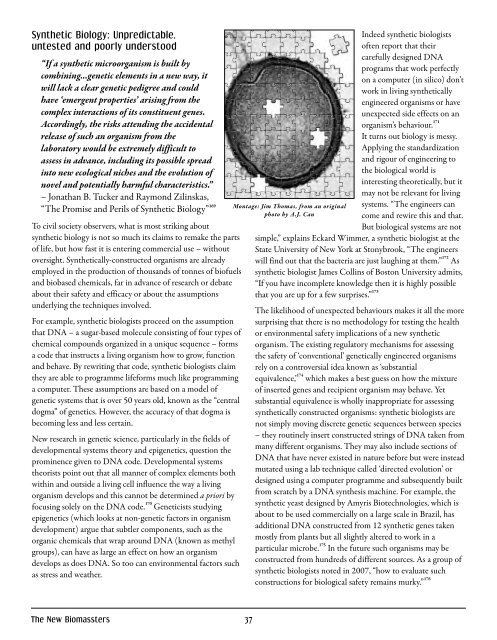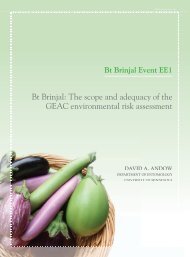English - pdf - 2145 Kb - Biosafety Information Centre
English - pdf - 2145 Kb - Biosafety Information Centre
English - pdf - 2145 Kb - Biosafety Information Centre
- No tags were found...
Create successful ePaper yourself
Turn your PDF publications into a flip-book with our unique Google optimized e-Paper software.
Synthetic Biology: Unpredictable,untested and poorly understood“If a synthetic microorganism is built bycombining…genetic elements in a new way, itwill lack a clear genetic pedigree and couldhave ‘emergent properties’ arising from thecomplex interactions of its constituent genes.Accordingly, the risks attending the accidentalrelease of such an organism from thelaboratory would be extremely difficult toassess in advance, including its possible spreadinto new ecological niches and the evolution ofnovel and potentially harmful characteristics.”– Jonathan B. Tucker and Raymond Zilinskas,“The Promise and Perils of Synthetic Biology” 169To civil society observers, what is most striking aboutsynthetic biology is not so much its claims to remake the partsof life, but how fast it is entering commercial use – withoutoversight. Synthetically-constructed organisms are alreadyemployed in the production of thousands of tonnes of biofuelsand biobased chemicals, far in advance of research or debateabout their safety and efficacy or about the assumptionsunderlying the techniques involved.For example, synthetic biologists proceed on the assumptionthat DNA – a sugar-based molecule consisting of four types ofchemical compounds organized in a unique sequence – formsa code that instructs a living organism how to grow, functionand behave. By rewriting that code, synthetic biologists claimthey are able to programme lifeforms much like programminga computer. These assumptions are based on a model ofgenetic systems that is over 50 years old, known as the “centraldogma” of genetics. However, the accuracy of that dogma isbecoming less and less certain.New research in genetic science, particularly in the fields ofdevelopmental systems theory and epigenetics, question theprominence given to DNA code. Developmental systemstheorists point out that all manner of complex elements bothwithin and outside a living cell influence the way a livingorganism develops and this cannot be determined a priori byfocusing solely on the DNA code. 170 Geneticists studyingepigenetics (which looks at non-genetic factors in organismdevelopment) argue that subtler components, such as theorganic chemicals that wrap around DNA (known as methylgroups), can have as large an effect on how an organismdevelops as does DNA. So too can environmental factors suchas stress and weather.Montage: Jim Thomas, from an originalphoto by A.J. CanIndeed synthetic biologistsoften report that theircarefully designed DNAprograms that work perfectlyon a computer (in silico) don’twork in living syntheticallyengineered organisms or haveunexpected side effects on anorganism’s behaviour. 171It turns out biology is messy.Applying the standardizationand rigour of engineering tothe biological world isinteresting theoretically, but itmay not be relevant for livingsystems. “The engineers cancome and rewire this and that.But biological systems are notsimple,” explains Eckard Wimmer, a synthetic biologist at theState University of New York at Stonybrook, “The engineerswill find out that the bacteria are just laughing at them.” 172 Assynthetic biologist James Collins of Boston University admits,“If you have incomplete knowledge then it is highly possiblethat you are up for a few surprises.” 173The likelihood of unexpected behaviours makes it all the moresurprising that there is no methodology for testing the healthor environmental safety implications of a new syntheticorganism. The existing regulatory mechanisms for assessingthe safety of ‘conventional’ genetically engineered organismsrely on a controversial idea known as ‘substantialequivalence,’ 174 which makes a best guess on how the mixtureof inserted genes and recipient organism may behave. Yetsubstantial equivalence is wholly inappropriate for assessingsynthetically constructed organisms: synthetic biologists arenot simply moving discrete genetic sequences between species– they routinely insert constructed strings of DNA taken frommany different organisms. They may also include sections ofDNA that have never existed in nature before but were insteadmutated using a lab technique called ‘directed evolution’ ordesigned using a computer programme and subsequently builtfrom scratch by a DNA synthesis machine. For example, thesynthetic yeast designed by Amyris Biotechnologies, which isabout to be used commercially on a large scale in Brazil, hasadditional DNA constructed from 12 synthetic genes takenmostly from plants but all slightly altered to work in aparticular microbe. 175 In the future such organisms may beconstructed from hundreds of different sources. As a group ofsynthetic biologists noted in 2007, “how to evaluate suchconstructions for biological safety remains murky.” 176The New Biomassters 37











